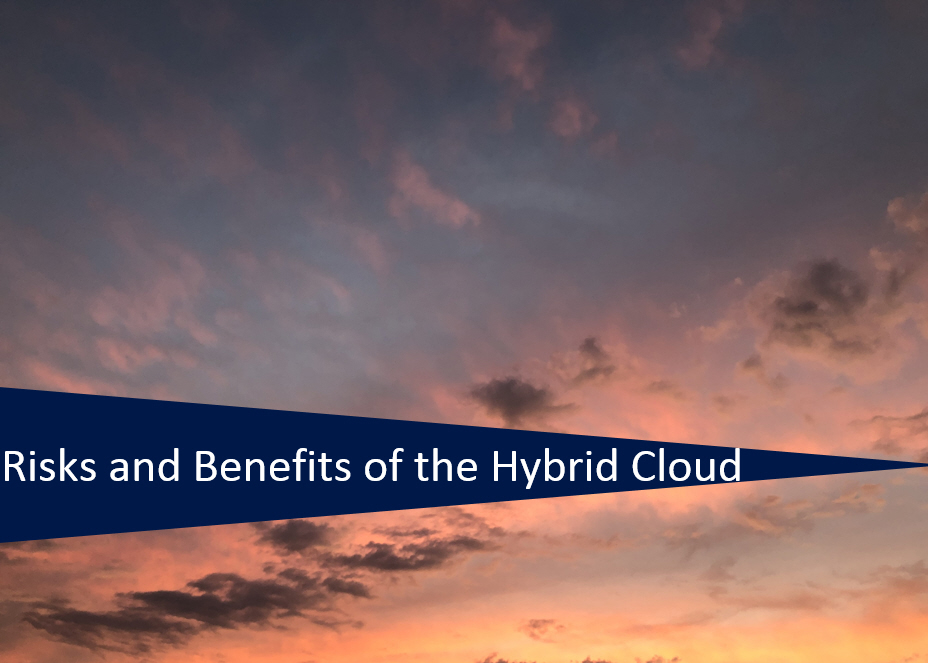
In a hybrid cloud environment, companies started to use a combination of public and private clouds that operated as separate entities but were integrated. Now, companies are expanding their hybrid cloud by more and more integrating on premises applications.
This means that in a hybrid cloud, a customer combines services from a private cloud and a public cloud by being connected through an effective WAN and is sending and sharing data between those different cloud services. The company depends on the availability of a public cloud platform from a trusted third party cloud service provider whereas a private cloud is either at the company’s premises or connected through a hosted private cloud service provider.
Hybrid cloud can include on premises data centers and the customer can still use on premises servers and manage the workloads between different environments such as the public cloud, private cloud and on premises servers.
Originally, the hybrid cloud concept was to extend capacity from a private cloud to a public cloud without using on premises servers. Today, it is a mixture of all three – private cloud, public cloud and on premises applications. This allows companies to be more flexible for deploying workloads, whether it is the best use of on premises for compliance or sensitive data reasons or achieving a higher scale for high volume and low sensitive data in the public cloud.
Depending on their IT strategies, companies tend to go for vendors offering solutions across different technology platforms such as Anthos from Google, OpenShift (Red Hat) from IBM and VMware Cloud from VMware. With this approach, companies are using tools to manage different environments by stretching down services to locations. They manage their clouds at different vendors.
The other approach is to go for vendors who more reflect what the customers already have in their data centers and it allows customers also to control their data centers. Examples are AWS Outposts from AWS, Azure Stack Hub from Microsoft or Cloud@Customer from Oracle like explained in below approach.
For example, a company uses a private cloud environment (i.e. Oracle’s Dedicated Region Cloud@Customer) for a part of its data and outsources other data to a public cloud (e.g. Microsoft Azure, AWS, Google or another public cloud service provider).
The aim is to create real business value by combining services and data from different cloud models through a consolidated, unified, automated and well managed IT environment. Companies take advantage of system interoperability and expect from a hybrid cloud to scale out and quickly provision new resources while being able to move workloads and data between the private and public cloud environments. The connection of a company on premises private cloud services with an external vendor’s public cloud services into a single infrastructure allows a company flexibility for running its applications and workloads.
Reasons to use the hybrid cloud is historically conditioned where companies started moving to the cloud and ended up in a hybrid environment. It can also be from using analytics and workloads in the cloud to using whole applications. Other reasons can be end of life of data centers which require business transformation to the hybrid cloud. Some companies only transfer some workloads into the hybrid cloud whereas other companies take the full advantage of using frameworks with calculation models, artificial intelligence and machine learning, often provided by cloud service providers or dedicated vendors.
Hybrid cloud adoption also depends whether the company is regulated such as finance, insurance and pharmaceutical companies or whether the company is already a digital native company like the ones from Silicon Valley. On the other side you will find a traditional company or a government institution which is more cautious towards the cloud.
In the past, public clouds and private clouds were easily defined by location and ownership.
Today, this became more complex:
- Public clouds traditionally ran off-premises, but public cloud providers are now running cloud services on their clients’ on premises data centers.
- Private clouds traditionally ran on premises, but organizations are now building private clouds on rented, vendor owned data centers located off premises.
- Business wants to obtain services faster and easier instead of investing into hardware, building skills and having administration staff to take care of operations.
The fact that companies can get the full managed service from the cloud is a strong argument for companies for whom IT is only a tool for their core business. Nevertheless, IT has moved more to a consumption based model instead of investing in your own infrastructure. You can buy and use hybrid cloud services as you need them.
For example a company runs basic and non-sensitive workloads on the public cloud and keep business critical and security intense applications and data in the private cloud or on their premises legacy systems, both safely behind the company’s firewall where data can be send to the private cloud and vice versa. The company can leverage their SaaS application and move data between their private or data center resources. Business processes are designed as a service so that they can connect with different private and public cloud environments as though they were a single environment.
Hybrid clouds become increasingly complex infrastructures and in the meantime, companies are challenged to keep operations stable and efficient. The question remains on how companies decide which part of their processes to manage, purchase and use. To come to the right balance, companies need to define the future state of their responsiveness and flexibility for their business, customers, partners and end users.


